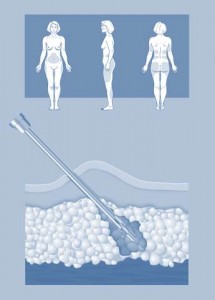What’s more Risky? Bone Marrow Aspiration or Liposuction?
There are a few common sources of stem cells for regenerative medicine. These are blood, fat, and bone marrow. I’ve seen numerous research articles and web-sites suggesting that a bone marrow aspiration used to obtain stem cells has a high complication rate when compared to liposuction. While we use fat for structural grafts in our Regenexx-AD procedure, we’ve never considered liposuction safer or more comfortable than a bone marrow aspiration (BMA) procedure. We’ve studied the discomfort of a properly anesthetized bone marrow procedure used to obtain stem cells in our own patients and found it to be very comfortable for the vast majority of people and feel discomfort during liposuction is similar. On the complications side, while we’ve seen very few issues with both procedures, they have different levels of invasiveness. Since liposuction involves placing a larger needle or probe into the fatty area under the skin and moving that probe about to break up the fatty tissue (which can potentially harm arteries, nerves, and other structures), we consider liposuction more invasive than BMA. This is because on the other hand, a bone marrow aspiration involves placing a needle through the skin in a direct route into the bone (more similar to a complex blood draw). However, what does the research say about the safety of these two procedures? My analysis today of papers published on both techniques in the National Library of Medicine revealed that the complication rate of a bone marrow aspiration is actually far less than liposuction. Depending on the study, liposuction is approximately 4-100 times more risky in terms of reported complications than a bone marrow aspirate. While serious complications like deaths, skin necrosis, permanent scarring, and blood clots are reported for liposuction, none are reported for bone marrow aspiration. To be completely fair, the type of limited liposuction performed for an orthopedic procedure is much less invasive than the types reported in many of the studies below. However, the statement that a bone marrow aspirate used to obtain stem cells is more invasive than liposuction is not at all supported by the medical research.
The Review of Recent Research:
In one study of 700 patients undergoing bone marrow aspiration, no complications were reported. In another study, 49 patients were studied who underwent large volume bone marrow aspiration (>1,000 ml vs. the 70 ml we usually harvest), there were no complications. In one UK study, out of 20,323 bone marrow aspirations, only 15 adverse events were reported (complication rate of less 0.01% or less than 1 in 1,000). These aspirates were much more aggressive than we would perform for stem cell harvest.
Out of 2,398 superficial liposuction cases, overall complication rate was 8.6% (208 patients). There were four cases of skin necrosis and two infections (skin necrosis means the skin died off). The safety of tumescent local anesthesia liposuction in 3,240 patients was studied and complications were found to occur in 9 patients, or 1 in 360. In another study of 609 consecutive patients undergoing ultrasound assisted liposuction the complication rate was 1.36%. There were two cases of low blood pressure and 7 local complications (3 fluid collections (seroma), 3 cases of dermatitis, 1 case of excessive bleeding). There are various single case reports found of deaths, blindness, severe scarring, serious blood clots, etc… due to liposuction.

NOTE: This blog post provides general information to help the reader better understand regenerative medicine, musculoskeletal health, and related subjects. All content provided in this blog, website, or any linked materials, including text, graphics, images, patient profiles, outcomes, and information, are not intended and should not be considered or used as a substitute for medical advice, diagnosis, or treatment. Please always consult with a professional and certified healthcare provider to discuss if a treatment is right for you.

